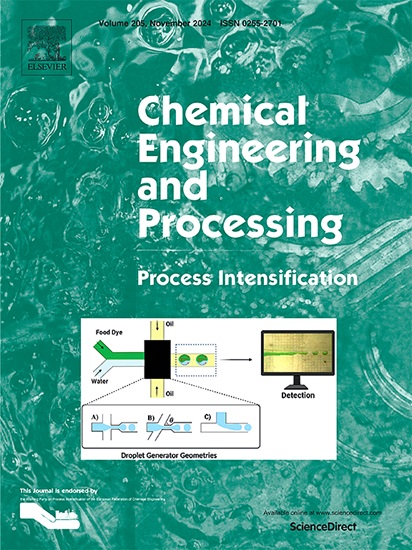Molecular investigation of pyrolysis and thermal gasification pathways in polyethylene microplastics degradation
IF 3.8
3区 工程技术
Q3 ENERGY & FUELS
Chemical Engineering and Processing - Process Intensification
Pub Date : 2025-03-28
DOI:10.1016/j.cep.2025.110285
引用次数: 0
Abstract
Polyethylene (PE) microplastics are a persistent environmental threat due to their widespread presence and potential for long-range transport. This study uses reactive molecular dynamics (ReaxFF) simulations to explore the atomic-level thermal degradation mechanisms of PE microplastics through pyrolysis and thermal gasification (TG). A key finding of the research is the comparison of activation energies for pyrolysis and TG. Results show that pyrolysis begins with chain scission, producing volatile compounds, while TG generates hydrogen, carbon monoxide, water, and small hydrocarbons. Oxygen plays a key role in controlling gas fractions during TG. The activation energy for pyrolysis is 315 kJ/mol, higher than TG, which ranges from 197 to 262 kJ/mol depending on oxygen content, indicating TG is a more efficient degradation pathway. These findings offer molecular insights into PE microplastic degradation, aiding the development of targeted remediation strategies and advancing research on microplastic waste treatment.

热解和热气化途径在聚乙烯微塑料降解中的分子研究
聚乙烯(PE)微塑料由于其广泛存在和远距离运输的潜力,是一个持续的环境威胁。本研究利用反应分子动力学(ReaxFF)模拟研究了PE微塑料通过热解和热气化(TG)的原子水平热降解机制。研究的一个关键发现是热解活化能和热重活化能的比较。结果表明,热解从断链开始,产生挥发性化合物,而TG生成氢、一氧化碳、水和小碳氢化合物。在热重过程中,氧在控制气体组分中起关键作用。热解的活化能为315 kJ/mol,高于TG,根据氧含量的不同,其活化能在197 ~ 262 kJ/mol之间,表明TG是一种更有效的降解途径。这些发现为PE微塑料降解提供了分子视角,有助于制定有针对性的修复策略,并推进微塑料废物处理的研究。
本文章由计算机程序翻译,如有差异,请以英文原文为准。
求助全文
约1分钟内获得全文
求助全文
来源期刊
CiteScore
7.80
自引率
9.30%
发文量
408
审稿时长
49 days
期刊介绍:
Chemical Engineering and Processing: Process Intensification is intended for practicing researchers in industry and academia, working in the field of Process Engineering and related to the subject of Process Intensification.Articles published in the Journal demonstrate how novel discoveries, developments and theories in the field of Process Engineering and in particular Process Intensification may be used for analysis and design of innovative equipment and processing methods with substantially improved sustainability, efficiency and environmental performance.

 求助内容:
求助内容: 应助结果提醒方式:
应助结果提醒方式:


